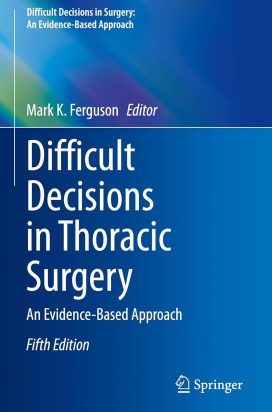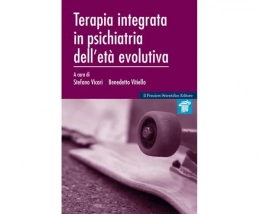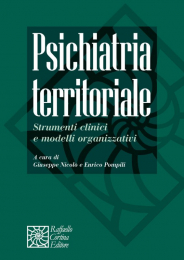Non ci sono recensioni
DA SCONTARE
As the complexity of decision-making in medicine, and surgery in particular, is growing exponentially, this book provides a practical guide to decision-making in thoracic surgery. It offers guidance on how to select among the varied and complex approaches that new technology provides. Concise and easy to follow chapters are devoted to one or two specific questions or decisions in thoracic surgery, aiding the reader to develop their decision-making skills.
Difficult Decisions in Thoracic Surgery offers clearly formatted and evidence-based chapters to help the reader navigate the complexities of thoracic surgery. All new chapters bring insight into the challenges faced operating on the lung, esophagus, diaphragm, airway, pleaura, mediastinum, and chest wall.
The book is relevant to practicing surgeons, surgeons in training, as well as medical professionals working with thoracic diseases.
-
Front Matter
Pages i-xvi
-
Introduction
- Mark K. Ferguson
Pages 1-14
-
Evidence Based Medicine: Quality of Evidence and Evaluation Systems
- Apoorva Krishna Chandar, Yngve Falck-Ytter
Pages 15-29
-
Decision Analytic Techniques and Other Decision Processes
- Varun Puri, Bryan F. Meyers
Pages 31-41
-
Decision Making: The Surgeon’s Perspective
- Thomas K. Varghese Jr.
Pages 43-53
-
Involving Patients in Difficult Decisions About Having Surgery
- Joshua A. Hemmerich, Kellie Van Voorhis, Mark K. Ferguson
Pages 55-65
-
ERAS
-
Front Matter
Pages 67-67
-
Does Early Postoperative Ambulation Improve Surgical Outcomes After Lung Resection for Cancer?
- Alicia Bonanno, Felix Fernandez
Pages 69-77
-
Does Reduction of Postoperative Opioid Use Lessen Opioid Dependence After Lung Resection for Cancer?
- Abhinav Kareddy, Marissa Mayor, Linda W. Martin
Pages 79-86
-
Does Carbohydrate Loading Improve Outcomes After Esophagectomy?
- Jessie A. Elliott, Elles Steenhagen, Richard van Hillegersberg
Pages 87-99
-
Is Intraoperative Fluid Restriction Effective in Reducing Complications After Esophagectomy?
- Erik Stiles, Michal Hubka
Pages 101-109
-
Does Early Post-Operative Feeding Improve Outcomes After Esophagectomy?
- Sadia Tasnim, Monisha Sudarshan
Pages 111-123
-
Does Early Postoperative Ambulation Improve Surgical Outcomes After Esophagectomy?
- Sabita Jiwnani, Karthik V
Pages 125-133
-
-
Prehabilitation
-
Front Matter
Pages 135-135
-
Exercise Prehabilitation and Lung Resection
- Sara Kim, Maria Lucia L. Madariaga
Pages 137-144
-
Nutritional Prehabilitation and Lung Resection
- Nuria M. Novoa, Maria Teresa Gómez Hernández, José Luis Campo-Cañaveral de la Cruz
Pages 145-154
-
Prehabilitation Before Esophagectomy: What Are the Benefits of Exercise?
- Anne M. S. de Hoop, Elja A. E. Reijneveld, Jelle P. Ruurda
Pages 155-169
-
Nutritional Prehabilitation and Esophagectomy
- Junya Oguma, Hiroyuki Daiko
Pages 171-178
-
Exercise Prehabilitation and Radical Surgery for Pleural Mesothelioma
- Brian Housman, Andrea Wolf
Pages 179-192
-
-
Lung
-
Front Matter
Pages 193-193
-
Lung
-
Reducing Surgical Morbidity After Lung Resection: Effects of Smoking Cessation
- Emily Wright, Robert M. Van Haren
Pages 195-204
-
- Francesco Guerrera, Pietro Bertoglio
Pages 205-215
-
Which Is the Optimal Platform for Robotic-Assisted Diagnostic Bronchoscopy?
- Yahya Alwatari, Janani S. Reisenauer
Pages 217-225
-
Dye vs. Fiducial Marking for Targeted Sublobar and Wedge Resection
- Abhinav Agrawal, Septimiu Murgu
Pages 227-240
-
Utility of MVO2 vs. Ventilatory Efficiency (VE/VCO2) in Assessing Lung Resection Risk
- Alessandro Brunelli
Pages 241-246
-
Optimal Timing of Early-Stage Lung Cancer Resection
- Nikki E. Rossetti, Steven Tohmasi, Varun Puri
Pages 247-255
-
Can Wedge Resection Supplant Segmentectomy for Small Peripheral NSCLC?
- Haiquan Chen, Yang Zhang, Fangqiu Fu
Pages 257-266
-
Does Vein First Hilar Division Improve Survival After Lung Cancer Resection?
- Jules Lin
Pages 267-280
-
Segmentectomy Versus Lobectomy in Patients with Good Pulmonary Function: Oncologic Outcomes
- Arvind Kumar, Chi-Fu Jeffrey Yang
Pages 281-287
-
- Stijn Vanstraelen, Gaetano Rocco
Pages 289-297
-
Does Induction Immunotherapy Confer Increased Operative Risk for Lung Resection
- Kenneth Seastedt, Sai Yendamuri
Pages 299-310
-
Wedge Resection Versus Stereotactic Body Radiotherapy in Stage I Non-small Cell Lung Cancer
- Claire Wunker, Nirmal Veeramachaneni
Pages 311-321
-
Salvage Resection After Definitive Radiation Therapy for Stage I Non-small Cell Lung Cancer
- Mark F. Berry
Pages 323-335
-
Is Assessment of cDNA Useful in Surveillance After Lung Cancer Resection
- Kezhong Chen, Yue He, Zifan Li, Jun Wang
Pages 337-345
-
-
Esophagus
-
Front Matter
Pages 347-347
-
Is Mucosal Eradication an Effective Intervention for Barrett Esophagus with Dysplasia?
- Vincent Bos, Roos E. Pouw
Pages 349-355
-
Do Oral Hygiene Interventions Affect Surgical Outcomes After Esophagectomy
- Takayuki Tsuji, Masashi Takeuchi, Satoru Matsuda, Hirofumi Kawakubo, Yuko Kitagawa
Pages 357-362
-
Is Measurement of Lung Function Helpful in Assessing Risk of Esophagectomy?
- Nicola B. Raftery, Jessie A. Elliott
Pages 363-373
-
Preoperative Biomarkers in Gastro-oesophageal Adenocarcinoma
- Stephen Lee, Marian Priyanthi Kumarasinghe
Pages 375-385
-
Induction Chemotherapy vs Chemoradiotherapy for Esophageal Adenocarcinoma
- James Tankel, Lorenzo Ferri
Pages 387-399
-
Esophagus
-
Delayed Surgical Intervention After Induction Chemoradiotherapy for Esophageal Cancer
- Swathikan Chidambaram, Sheraz Rehan Markar
Pages 401-410
-
Right vs Left Thoracic Approach for Esophageal Adenocarcinoma
- Zhen Wang, Yousheng Mao
Pages 411-419
-
Resection of 15 or More Nodes Improves Survival in Esophageal Cancer Treatment
- Eisuke Booka, Hiroya Takeuchi
Pages 421-426
-
Organ Sparing Therapy for Locally Advanced Esophageal Cancer
- Berend J. van der Wilk, Bo J. Noordman, Bas P. L. Wijnhoven
Pages 427-438
-
Can Goals for Early Postoperative Ambulation After Esophagectomy Be Established?
- N. Schuring, S. S. Gisbertz
Pages 439-447
-
Is EndoFLIP™ Helpful in Individualizing G-POEM for Delayed Gastric Emptying After Esophagectomy
- Herbert Mason Hedberg
Pages 449-454
-
Optimal Initial Therapy for Achalasia
- Kyle Von Schimmelmann, Dillon Wade, Kalyana C. Nandipati
Pages 455-464
-
Are Stents Good Enough for Routine Initial Therapy of Esophageal Perforation?
- Hope Conrad, Stephanie G. Worrell
Pages 465-475
-
The Utility of EndoFLIP in Individualizing POEM for Achalasia
- Belinda Hughes, William Knight, Abraham Botha
Pages 477-483
-
Peroral Endoscopic or Open Myotomy for Zenker’s Diverticulum
- Simon Y. W. Che, Michael B. Ujiki
Pages 485-491
-
-
Mediastinum
-
Front Matter
Pages 493-493
-
Does MRI Contribute to the Accuracy of Thymoma Diagnosis?
- Luis Landeras, Lydia Chelala
Pages 495-504
-
Thymectomy in the Setting of Synchronous Pleural Metastases
- Rajika Jindani, Brendon Stiles
Pages 505-511
-
Pleural Metastasectomy for Regionally Disseminated Recurrence of Thymoma
- Nicolas Zhou, Mara B. Antonoff
Pages 513-520
-
Controversies in Cardiac Sympathetic Denervation for Ventricular Arrhythmias
- Joseph Hadaya, Jane Yanagawa
Pages 521-530
-
-
Pleura
-
Front Matter
Pages 531-531
-
Is tPA/DNase Effective Routine Initial Therapy for Pleural Empyema?
- Willfredy Castano, Moishe Liberman
Pages 533-545
-
- Joseph J. Platz, Keith S. Naunheim
Pages 547-553
-
Survival: Pleural Resection Vs Nonsurgical Management of Pleural Mesothelioma
- Ava Ferguson Bryan, Darren S. Bryan
Pages 555-560
-
-
Airway
-
Front Matter
Pages 561-561
-
-
Pages 617-623
-
-
Chest Wall
-
Front Matter
Pages 625-625
-
Regional Vs Intercostal Blocks for Minimally Invasive Thoracic Surgery
- Don Walsh, Aneurin Moorthy
Pages 627-641
-
Optimal Duration of Nuss Bar Implant for Pectus Deformities
- Maurizio Valentino Infante, Alessio Campisi
Pages 643-654
-
Intrathoracic or Extrathoracic Fixation of Rib Fractures
- Jacob Hessey, Elana Maccou
Pages 655-661
-
-
Complementary Medicine
-
Front Matter
Pages 663-663
-
A Survey of Perioperative Applications of Traditional Chinese Medicine
- Mark K. Ferguson
Pages 665-673
-
-
Corrections to: Does Early Postoperative Ambulation Improve Surgical Outcomes After Esophagectomy?
- Sabita Jiwnani, Karthik V
Pages C1-C1
-
Back Matter
Pages 675-680
-
-
-




